|
Chapter 1 Health Status and Healthy Japan 21 |
| 1. Health Status and Utilization of Health Services |
|
To grasp the health status and utilization of health services, the government conducts regular survey on the nation. One is a questionnaire survey on households [National Household Survey, NHS] and the other is a survey on hospitals and clinics [Patient Survey]. According to the NHS conducted in June 2001, 32.3% of the population has at least one physical complaints. The percent of those who express at least one physical 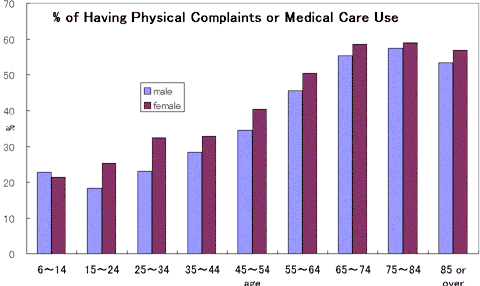 complaints increases with age in both sexes. The figure is a slight increase from 3 years ago (30.5% in 1998 survey), which may reflect the aging of the population. NHS also surveys the perceived health status of the population. Asked how they perceive their health status, 40.6% of the population aged 6 years or over answered that their health is good or fair while 11.5% answered "not good" or "bad". 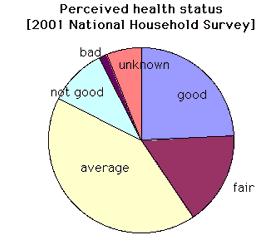 International comparison of perceived health status reveals somewhat interesting findings. The OECD Health Data compares the percent of those who perceive their health status "good" as shown in the following graph. In the comparison year of 1998, 44.5% of the Japanese perceived their health as either "good" or "fair" almost on a par with the figure of Koreans. On the other hand, the U.S. and Canada had a far higher figure of nearly 90%. One might be cautioned in interpreting these findings because such subjective perception may involve methodology of survey and cultural attitudes. 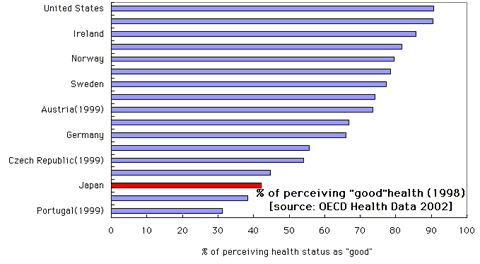 Utilization of medical care is estimated by Patient Survey conducted every three years. Patient Survey is a nation-wide sampling survey on inpatients and outpatients of hospitals and clinics and is conducted on one day in middle of October every three years, the latest of which was conducted in October 1999. As of the survey date, 1.2% of the population is hospitalized and 5.4% of the population visited outpatient clinics. Age and sex-specific utilization expressed as the estimated number of patients per 100,000 population is displayed in the graph. The number of inpatient exceeds that of outpatient in the age groups of 90 or over in both sexes. 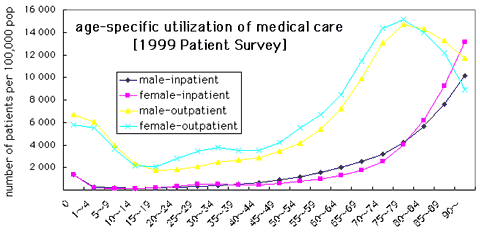 One should be cautioned that the estimated number of patients given in Patient Survey is a one-day sampling survey and underestimate the number of outpatients who regularly visit hospitals or clinics. The survey includes the interval of regular outpatient visits, and then the number of patients who are under constant medical treatment can be estimated by multiplying the number of patients on the survey day with the average interval, plus the number of inpatients. The estimated number of patients in 10 most common diseases is displayed in the graph. Hypertension is by far the most common disease. Over than 7% of the entire population is under medical treatment with hypertension. 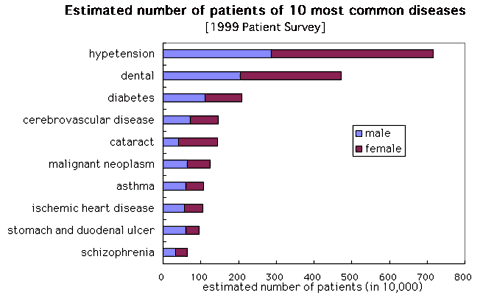 |
| 2. Healthy Japan 21 |
|
After achieving basic disease prevention, health promotional activities taken in the post war era was mainly directed toward enhancement of better nutrition and physical fitness. However, after achieving the life span of 80 years in and around 1978, the purposes of such activities gradually shifted toward improvement of quality of life rather than quantitative prolongation of the life span. The 1st National Movement for Health Promotion was launched in 1978 and the 2nd wave was launched in 1988. One of the major measures taken in the 1st was establishing the Municipal Health Centers (MHC) in every municipality as the facility for health promotional activities in addition to the existing Public Health Centers (PHC). The 2nd wave was dubbed "Active 80 Health Plan" after its purposes to cater to the prolonged life span 80 years. After more than 20 years since its inception, these health promotional activities are beginning to bear the fruits. As the 3rd wave of national health promotion movement, the Healthy Japan 21 is currently being actively promoted. The covered period is between the year 2000 and 2010 with defined set of goals. In this wave, emphasis is placed in the prolongation of "healthy life span" which means the life span without disability. This emphasis reflects resentment over a considerable number of elderly with disability in the face of the world longest life span. (1) Promotion of Physical Fitness To promote physical fitness, qualification of "Health Trainers" was initiated in 1988. Health Trainers possess knowledge of both medical and physical science to make prescription for recommended physical activities tailored to individual conditions and medical needs. Also, fitness clubs that satisfy certain requirements such as having a certain number of qualified health trainers may be given special designation by government. Although such designation will not entitle them to health insurance benefit, the membership fee for patients with chronic diseases such as hypertension, diabetes and hyperlipidemia will enjoy tax-exempt status if their physical activities regimen is prescribed by attending doctors and supervised by qualified health trainers. (2) Health Information System A variety of health information system including the cancer treatment support system, cardiovascular treatment support system, the surveillance system for tuberculosis and infectious diseases and the treatment support system for intractable diseases are provided by the "Health Promotion Foundation" since 1997. These information systems are available through the internet [http://www.health-net.or.jp] and the closed network between the ministry and local public health centers [WISH net]. |
| 3. Health Promotion Act |
|
As the legal basis of promoting the Healthy Japan 21, a new law named Health Promotion Act was enacted. This law is intended to promote healthy lifestyle, mandatory segregation of smoking are and coordinate health screening conducted by different providers under different schemes. So far, for example, employers are required to provide health screenings to workers under the Industrial Safety and Hygiene Act, and schools provide health screenings to pupils, and each health insurers provide health screenings to the insured with little coordination with each other. The new law makes the formats of health screening records uniform to assure consistent record keeping in every individual. The law also stipulates the National Health and Nutritional Survey and encourages both central and local governments to monitor the prevalence of lifestyle related diseases for effective health promotion. |
| 4. Health Related Problems |
|
(1) Tobacco Control According to the National Nutritional Survey in 2000, the smoking rate in Japan was 47.4% for male and 11.5% for female. Although the smoking rate for male has steadily been declining, it is still higher than most developed countries. The smoking rate for female is lower than most developed countries and is somewhat stable overall, but the smoking rate among young women in the 20s and 30s is increasing alarmingly. More alarming is the recent increase of the smoking rate among school children. According to the survey on junior and senior high school students conducted by government in 2000, the rate of "smoking in the last one month" increased in all grades: 36.9% of male and 16.2% of female students in 12th grade replied yes to the question. Moreover, 25,9% of male and 8.2% of female 12th grade students say they smoke everyday. Despite health risk involving smoking, the government used to be not so enthusiastic about tobacco control mainly because the tobacco industry was the monopolistic government enterprise and hence a valuable source of tax revenue. Only after the government enterprise was privatized to the present JT, the government started to tackle the problem wholeheartedly. The action plan for tobacco control was initiated in 1995. In cooperation to the plan, the tobacco industry voluntarily withheld nighttime operation of vending machines in 1997 and refrained from TV ads in 1998. The plan called for separation of smoking and nonsmoking space as part of the anti smoking efforts. The separation is enforced according to the types of facilities and is mandatory for health facilities and public facilities. 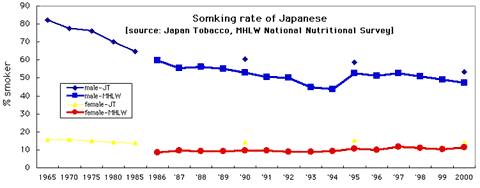 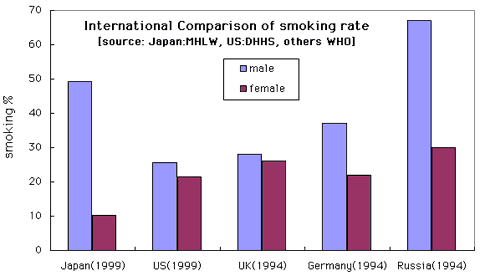 (2) Alcohol Problems The number of heavy drinker defined as drinking 150ml pure alcohol is increasing and is estimated to be approximately 2.4 million as of 1997. According to the Patient Survey, a nation wide sampling survey on hospitals and clinics conducted in every three years, the number of alcoholism patients under medical treatment increased from 14,720 in 1968 to 19,400 in 1999. Although the figures may appear small in comparison to the estimated number of heavy drinkers (2.4 million), the majority of alcoholism patients are considered to be under treatment for alcohol related conditions such as liver diseases. Japan does have the "Prohibition against Drinking for Minors Act", but its effectiveness is seriously hampered by ubiquitous vending machines of alcohol. In 1993, the governmental Public Health Committee urged the total ban of vending machines and limiting the alcohol sales to over-the-counter. |
  
|